
| WWT Shows | CLICK TO: Join and Support Internet Horology Club 185™ | IHC185™ Forums |

|
• Check Out Our... • • TWO Book Offer! • |
Welcome Aboard IHC185™  Internet Horology Club 185
Internet Horology Club 185  IHC185™ Discussion Site Main Page
IHC185™ Discussion Site Main Page  Open to the World RESEARCH FORUMS
Open to the World RESEARCH FORUMS  Hamilton and 992B Research Forum
Hamilton and 992B Research Forum  Hamilton 992, 992E, and 992B Case & Dial Identification. (1924-1971)
Hamilton 992, 992E, and 992B Case & Dial Identification. (1924-1971)
 Internet Horology Club 185
Internet Horology Club 185  IHC185™ Discussion Site Main Page
IHC185™ Discussion Site Main Page  Open to the World RESEARCH FORUMS
Open to the World RESEARCH FORUMS  Hamilton and 992B Research Forum
Hamilton and 992B Research Forum  Hamilton 992, 992E, and 992B Case & Dial Identification. (1924-1971)
Hamilton 992, 992E, and 992B Case & Dial Identification. (1924-1971)Page 1 2
 Topic Closed
Topic ClosedGo  | New Topic  | Find-Or-Search  | Notify  | Tools  |
For Your Information... I put together a basic guide to identify Hamilton 992 series dials during the "factory cased" 1924-1971 era. It's just a guideline as there are exceptions and variables. The pictures are images gathered online and therefore they vary as to image quality and dial condition. Hamilton changed dial numbers and descriptions throughout the years. The numbers and descriptions here are conclusions that I have reached from advertisements, catalogs, parts material lists and blue prints. Once again this is a basic guideline meant to identify a dial and describe it. These posts will be updated periodically as new information becomes available. Everyone please feel free to post or eMail input to improve these postings. RR The dials following coincide with Hamilton Factory Railroad cases...  | |||
|
Descriptions used... 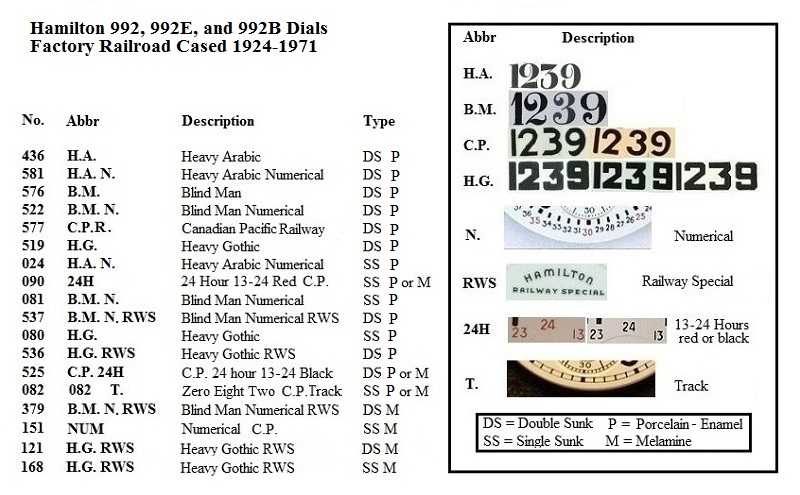 | ||||
|
Dial Numbers... | ||||
|
992 and 992E Dials... NOTE: The only dials we find offered as original to 992E movements are the 576, 522 and 519 described in Hamilton catalogs of that 1932-1939 time-frame. In addition the 581 appeared on the 992E in 1932-1933 catalogs. All 992E movements were factory cased and before that all 992 movements were factory cased after 1929 production.  | ||||
|
992B Dials in Porcelain-Enamel... 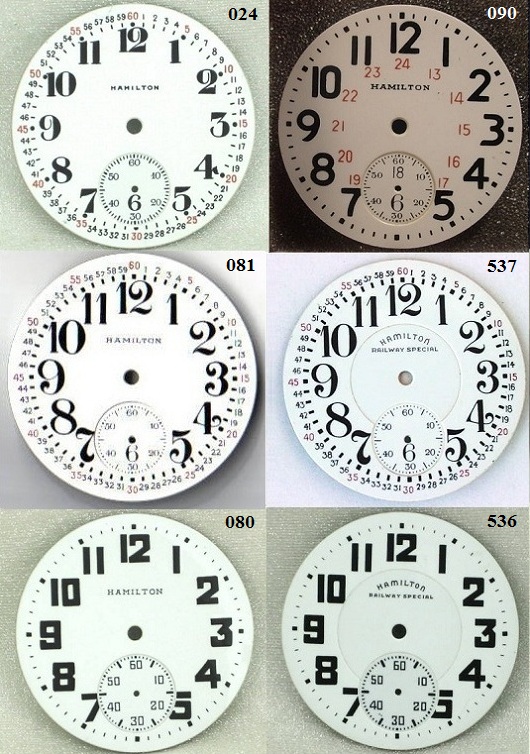 | ||||
|
992B Melamine Dials... NOTE: Hamilton began phasing-in the melamine dials in 1948 and by 1950 the change-over was complete. The earliest melamine dials were smooth and shiny but gradually the surface became increasingly dull and of greater porosity. Many survivors have surface cracks and loss of intensity on the numbers and letters.  | ||||
|
Melamine Comparison... Here is a compiled explanation and comparison that Lindell posted previously... Hamilton began phasing-in melamine dials in 1948 and by 1950 the change-over was complete for 992B movements, after that time no porcelain-enamel dial is considered to be correct by serious collectors. It is important to realize that in the 1940s melamine dials were viewed as a cost-cutting move that also introduced a new technology with perceived greater long-term durability. The earliest melamine dials were smooth and shiny but gradually the surface became increasingly dull and of greater porosity. Many surviving examples have surface cracks and loss of intensity on the numbers and letters. The more we study these dials the easier it becomes to spot noticeable differences between the porcelain-enamel and melamine dials on 992B movements. In the image below, on the left number 536 porcelain-enamel and on right 121 melamine version. Notice the "Hamilton Railway Special" signature and all the numbers are heavier, bolder and more squared looking on Porcelain-Enamel Heavy Gothic dials such as you see on the left in the image below this posting. Melamine HG dials like the one on the right below have 45º mitered corners on the 8, 9, 0, upper 2 and lower corners of the 3 and 5 numerals. Knowing these tips we can easily spot melamine dials at some distance away. Porcelain-Enamel 536 on left, Melamine 121 shown on right...  | ||||
|
992B Dials in Porcelain-Enamel and Melamine 525, 090, 082... Dial numbers 525, 090, and 082 were first produced in Porcelain-Enamel then Melamine versions were phased in as described above. Here are some ways to identify differences between them. The 525 dials have two different “HAMILTON” signatures. The porcelain-enamel dial signature letters are bolder and square whereas the melamine version letters are not as pronounced and the letters M and N are rounded. Also, there is a difference in the size and location of the number 18 within the seconds bit. Notice on the 090 dials the porcelain-enamel dial has a black number 18 in the seconds bit and the melamine dial has a red number 18. The number 6 hour font within the seconds bit is also different between the two dials. Looking at the 082 porcelain-enamel dial numerals you can see they are bolder especially on the hour numbers 4 and 8 where there is a noticeable difference of how much white is visible inside the numerals. The porcelain-enamel dials will typically be shinier and brighter. Porcelain-Enamel Dials on the left, Melamine Dials shown on right...  | ||||
|
Time frames for case and dial usage... Posts by Lindell on April 6, 2009 for cases and Mitch Markovitz on June 30, 2009 for dials in this topic: "Identify Your Hamilton 992 Series Factory Case!" For additional Wadsworth factory case information always be sure to consult: "Hamilton Wadsworth Case Numbers History and Database" RR | ||||
|
NOTE: If a dial is signed only as "Hamilton" in script it is too early and incorrect for use in any of the cases illustrated above. Hamilton began to phase-out their script signature in 1918 and by the time their Crossbar Case was introduced in 1924 the Hamilton script signature as shown below was a thing of the past. Pre-1920s Hamilton script signature... 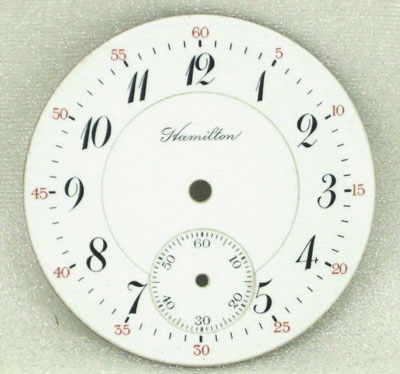 | ||||
|
This is a place-holder for additional information. RR | ||||
|
Please add or correct as needed. Thank you, RR | ||||
|
| Site Administrator IHC Life Member |
Very nice, Richard. This will be a great help.Thank you. | |||
|
| IHC Vice President Pitfalls Moderator IHC Life Member |
Good job Richard. I have bookmarked the page and made it a featured topic in this forum. Best Regards, Ed | |||
|
| IHC Life Member |
Looks like I have the wrong dial on my 992 Elinvar! The case is a Wadsworth #2, 10K Gold Filled, Pat. 5-22-26. Case serial number is H255985, and the movement number is 2,582,021. Thanks. 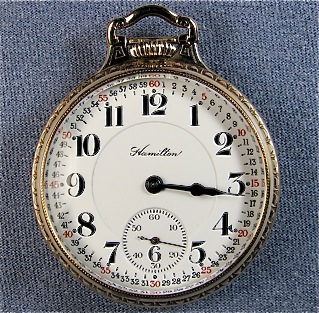 | |||
|
Great Reference. I've been pouring through numerous reference books and nothing lines it up this cleanly...thx very much. Gary | ||||
|
| IHC Life Member |
Richard Excellent work! Very good to have handy, so I'll try to print it out. Ed, very good idea. Regards, Krister. | |||
|
Richard, Great work on a confusing subject (for me). I for one appreciate all the time and effort you spent on this project. Ed | ||||
|
| IHC Life Member |
You have done a superb job and service to Horology & IHC185 Richard....I know how much work you put into this project and it was not easy getting it to fruition but patience is a virtue and will accomplish many things, my friend.... Congratulations...! Regards, Jerry | |||
|
| IHC President Life Member |
Outstanding work Richard, Your concise dial and case identification information will prove to be a great reference resource for experienced and novice collectors alike. This is a great addition to our Hamilton Research Forum data. Thanks a million, Lindell | |||
|
| IHC Life Member |
Richard my hat off to you. Your knowledge and generosity is second to none. Thank You Gene | |||
|
Bruce, The dial is on your Elinvar is pre-1920s which is too early for your movement which dates to 1930-1931 according to the Gelson List and your Model 2 case dates to 1938 according to the Wadsworth-Hamilton Case Database so it looks like things are more than a little mixed up. RR | ||||
|
Everyone, Thank you for the kind words. Jerry, Ed P., and Lindell have been extremely helpful and contributed to this project. Thanks for all the help gentlemen. RR | ||||
|
| IHC Life Member |
Richard, thanks for the info. | |||
|
| IHC Life Member |
Richard - I just found this posting, and am blown away! This is a great summary - thanks very much! Tom | |||
|
| IHC Member 1357 |
Thanks to you Richard,I now know my 992B has dial 121 instead of 536! Great job Richard and many thanks.Roger | |||
|
Thanks Richard - You are an true asset to our club. I find all your posts interesting and educational. | ||||
|
| IHC Member 1110 |
Really nice job, Rich! And all on one page makes it even better.Best Regards, Ted. | |||
|
Richard thanks for the great information. I have a question on the dial on a 992 E. It looks like the 519 shown above but the hour markers are triangular instead of square. Is this just a variation of the 519 or what? Hopefully it is legit since I bought it but don't have it yet. Thanks Bob 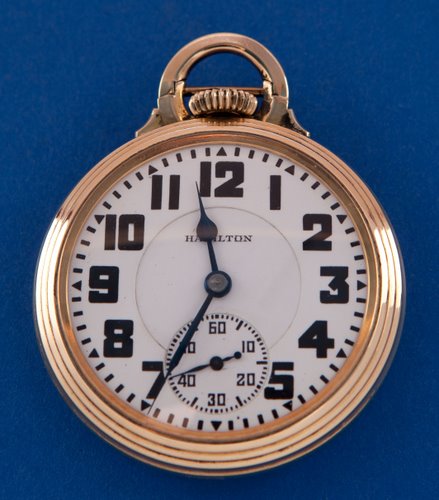 | ||||
|
Bob, You're welcome as well as all that have given thanks. That's a great looking dial which is definitely legit. I would describe it as an "Arrows Out" Heavy Gothic DS porcelain-enamel dial. It's a variation of the 519 dial except the five minute markers are triangular rather than rectangular. As far as I know there is no specific number for it. The dial is an uncommon variant used on the 992E for a very short time. In conversation with Lindell he explained these "Arrows Out" dials were used by Hamilton approximately circa 1931-1937 plus or minus a year. Another variant of this dial was used on Illinois movements. The Illinois version looks the same except it is signed "Illinois" in an arch rather than the straight-line Hamilton, otherwise they are identical in appearance. RR | ||||
|
Richard thanks for that information. Lindell also contacted me to let me know that it is OK. He pointed me to a photo of one of his with that dial in the Hamilton Wadsworth database and gave me the movement number of that one. When I get the watch I will post the movement number so we can see how close to each other they are in time. | ||||
|
I got the 992E pictured above today. The movement number is 2599978 putting it in the 3rd run of 992E's which goes from 2597001 to 2608000, 1935-36-37. This is the same run as Lindell's (2606463) which is pictured in the Hamilton Wadsworth database. The Wadsworth case is # 0952156 which puts it in 1936. | ||||
|
| IHC Life Member |
Great work Richard! I just want to thank you, Lindell, and Ed for all of you hard work that went into a project like this. It is VERY informative and I have used it quite a lot to help, and show collectors the correct dials for their watches. Thanks again!! Larry | |||
|
| Powered by Social Strata | Page 1 2 |
| Your request is being processed... |
 Topic Closed
Topic ClosedWelcome Aboard IHC185™  Internet Horology Club 185
Internet Horology Club 185  IHC185™ Discussion Site Main Page
IHC185™ Discussion Site Main Page  Open to the World RESEARCH FORUMS
Open to the World RESEARCH FORUMS  Hamilton and 992B Research Forum
Hamilton and 992B Research Forum  Hamilton 992, 992E, and 992B Case & Dial Identification. (1924-1971)
Hamilton 992, 992E, and 992B Case & Dial Identification. (1924-1971)
 Internet Horology Club 185
Internet Horology Club 185  IHC185™ Discussion Site Main Page
IHC185™ Discussion Site Main Page  Open to the World RESEARCH FORUMS
Open to the World RESEARCH FORUMS  Hamilton and 992B Research Forum
Hamilton and 992B Research Forum  Hamilton 992, 992E, and 992B Case & Dial Identification. (1924-1971)
Hamilton 992, 992E, and 992B Case & Dial Identification. (1924-1971)©2002-2025 Internet Horology Club 185™ - Lindell V. Riddle President - All Rights Reserved Worldwide

